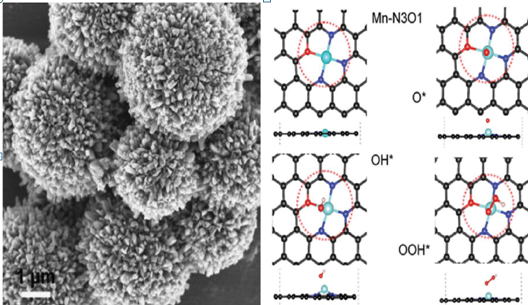Converting oxygen to other chemicals, the process called oxygen reduction reaction (ORR), is critical for energy generation technologies. ORR typically requires high-performing catalysts to proceed at a satisfactory speed. USTC researchers led by Prof. CHENG Qianwang from the School of Chemistry and Materials Science have designed a novel catalyst that could effectively promote ORR, in a way that Mn-containing enzymes in mother nature do so well.
In the developed catalyst, atomically dispersed O and N atoms coordinated Mn active sites are incorporated within the graphene frameworks, mimicking the structures of Mn-containing enzymes. Taking advantages of the conductive 3D graphene frameworks and the synergistic neighboring O-N atoms, the Mn active sites outperform the commercial Pt/C catalyst for the ORR and the zinc–air batteries under alkaline conditions. Theoretical calculations revealed the potential active sites to be Mn-N1O3, Mn-N2O2 and Mn-N3O1. The research opens new opportunities for the rational design of other nature-inspired single atom catalysts.
The research article entitled “O-, N-Atoms-Coordinated Mn Cofactors within a Graphene Framework as Bioinspired Oxygen Reduction Reaction Electrocatalysts” was published in Advanced Materials on May 28th with PhD candidate YANG Yang being the first-author and Profs. CHENG Qianwang and WANG Hui being the correspondents.

Field emission scanning electron microscopy of the catalyst (left) and the optimized Mn-N3O1 structure (potential active site) with ORR intermediate states O*, OH* and OOH* (right) / Images from YANG Yang
The research was supported by the National Natural Science, the Fundamental Research Funds for the Central Universities, the CAS/SAFEA International Partnership Program for Creative Research Teams and the Hefei Science Center CAS and a Most Grant.
(Written by XU Yunfei, edited by HUANG Danning,USTC News Center)